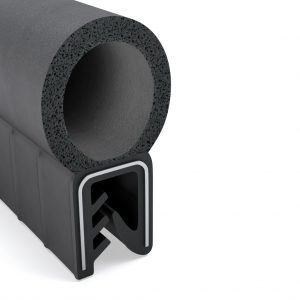Thermal expansion describes how much a material will increase in size when heated. Learn how this material property can affect the design and performance of heavy equipment gaskets.
Heavy equipment gaskets expand and contract at different rates than the metal or plastic surfaces that they seal. Thermal expansion, a property that indicates how much a material will expand when it’s heated, has a coefficient or multiplier that supports engineering calculations. Because different materials have different coefficients of thermal expansion, engineers need to consider what can happen when a rubber gasket and the surrounding surfaces behave differently.
For example, a hot day causes a rubber seal and metal door to expand. If both expand too much, the rubber will exceed the gap between the door and the frame. Proper sealing requires the right amount of gasket compression, but not at the expense of a door that won’t close. Conversely, heavy equipment gaskets that contract too much in the cold won’t fill the gap between the door and the door frame. The door may shut readily, but a gasket like this won’t keep out cold temperatures, wind, and weather.
More Thermal Expansion Examples
Changing temperatures in outdoor environments can also cause challenges. Consider the example of a tractor trailer that travels from Miami to Montreal on a January day. At the start of the trip, the weather is hot, the door seal seems swollen, and the driver can barely close the cargo door. By the end of the run, the seal seems shrunken from the cold. Because this contraction was excessive, the seal failed to fill the gap between the door and the frame, allowing windblown snow to reach the load.
Temperature changes inside of a vehicle can also be challenging. For example, the big diesel engines that power heavy equipment produce significant amounts of heat. Inside the engine bay, rubber hoses are used with pipes and clamps. If engine heat causes these hoses to expand too much, the hose may swell past the clamps, which can impede the flow of fluids or gases. Hood seals and other types of heavy equipment gaskets also expand and contract with changing engine bay temperatures.
Temperature Gets Complicated
Seal design isn’t just about thermal expansion, of course. There are plenty of other factors to consider, including some that don’t involve temperature, or that combine temperature with other variables. When it comes to heat and cold then, there’s plenty to consider. For example, engineers need heavy equipment gaskets that can withstand a full range of operating or service temperatures, a concept we’ll cover in a future blog entry. Material properties such as oil resistance are also affected by high heat or extreme cold.
When it comes to thermal expansion, the relationship belong elongation and temperature isn’t as simple as “heat expands, cold contracts”. The linear elongation of rubber increases over a specific temperature range and then decreases at still higher temperatures. If the rubber is subjected to tensile stress, the Joule effect become a factor. Imagine a rubber band holding a heavy object. At room temperature, the rubber band expands with the load. If you apply too much heat, however, the rubber band won’t stretch enough.
Heavy Equipment Gaskets from Elasto Proxy
Temperature calculations can get complicated, which is why engineers who design heavy equipment gaskets want a supplier with both application experience and technical expertise. Elasto Proxy has been supplying the mobile equipment industry with heavy equipment gaskets for over 30 years. From design assistance and help with material selection to expert custom fabrication and value-added services such as kitting and custom packaging, we offer a complete solution. To learn more, contact us.









